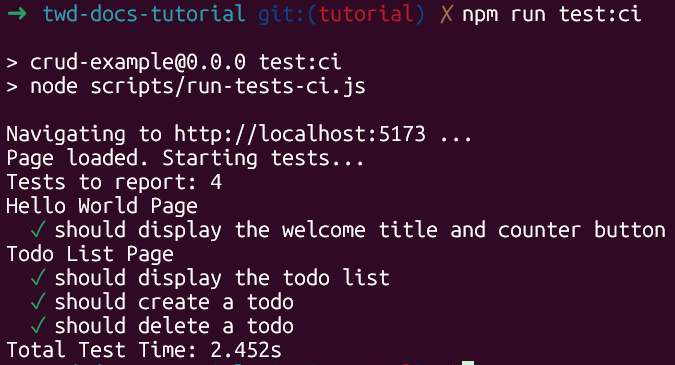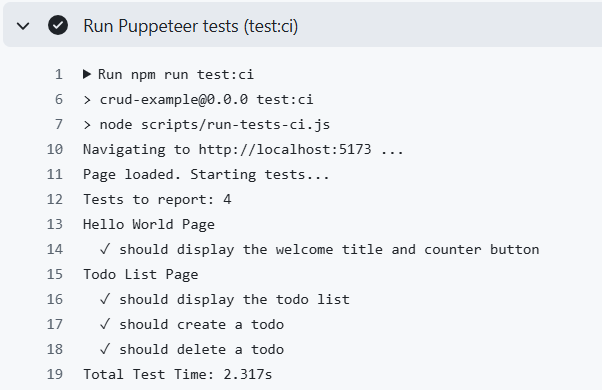CI Integration - Running Tests in Continuous Integration
In the previous tutorial, we explored one of TWD's core features — network mocking — and completed our first full set of tests. Now, it's time to take the next step: running those tests in the terminal so we can integrate them into a CI workflow.
Looking for the quickest path? Install
twd-cli(npx twd-cli run) and you’ll have a ready-made CI runner that handles Puppeteer setup, config, coverage, and exit codes for you. The rest of this guide shows how to build the same flow yourself so you can customize every step. Check the updated CI Execution docs for the latest CLI options and ready-to-copy workflow snippets.
To roll your own runner, we’ll still use Puppeteer and one of TWD's utilities, reportResults, to display test results directly in the console.
Before You Start
If you're following along from the previous tutorial, you can continue as is. But if you want to reset your repo or make sure you're on the correct branch:
# Repo git clone git@github.com:BRIKEV/twd-docs-tutorial.git
git reset --hard
git clean -d -f
git checkout 04-ci-integration
npm run serve:devRunning Tests in the Terminal
TWD exposes its runner on the window object, which means you can programmatically execute your tests from any environment — including tools like Puppeteer.
Here's the basic version of that script:
import { reportResults } from 'twd-js/runner-ci';
const TestRunner = window.__testRunner;
const testStatus = [];
const runner = new TestRunner({
onStart: () => {},
onPass: (test) => {
testStatus.push({ id: test.id, status: "pass" });
},
onFail: (test, err) => {
testStatus.push({ id: test.id, status: "fail", error: err.message });
},
onSkip: (test) => {
testStatus.push({ id: test.id, status: "skip" });
},
});
const handlers = await runner.runAll();
// report results
reportResults(handlers, testStatus);That's the core logic we need to run TWD tests headlessly — but we still need a way to access the window context. Let's do that by using Puppeteer.
Step 1. Install Dependencies
npm install --save-dev puppeteerStep 2. Create a CI Script
Let's create a new file: scripts/run-tests-ci.js:
import puppeteer from "puppeteer";
import { reportResults } from 'twd-js/runner-ci';
const browser = await puppeteer.launch({
headless: true,
args: ['--no-sandbox', '--disable-setuid-sandbox'],
});
const page = await browser.newPage();
console.time('Total Test Time');
try {
// Navigate to your development server
console.log('Navigating to http://localhost:5173 ...');
await page.goto('http://localhost:5173');
// wait to load data-testid="twd-sidebar"
await page.waitForSelector('[data-testid="twd-sidebar"]', { timeout: 10000 });
console.log('Page loaded. Starting tests...');
// reload page
// Execute all tests
const { handlers, testStatus } = await page.evaluate(async () => {
const TestRunner = window.__testRunner;
const testStatus = [];
const runner = new TestRunner({
onStart: () => {},
onPass: (test) => {
testStatus.push({ id: test.id, status: "pass" });
},
onFail: (test, err) => {
testStatus.push({ id: test.id, status: "fail", error: err.message });
},
onSkip: (test) => {
testStatus.push({ id: test.id, status: "skip" });
},
});
const handlers = await runner.runAll();
return { handlers: Array.from(handlers.values()), testStatus };
});
console.log(`Tests to report: ${testStatus.length}`);
// Display results in console
reportResults(handlers, testStatus);
// Exit with appropriate code
const hasFailures = testStatus.some(test => test.status === 'fail');
console.timeEnd('Total Test Time');
process.exit(hasFailures ? 1 : 0);
} catch (error) {
console.error('Error running tests:', error);
process.exit(1);
} finally {
console.log('Closing browser...');
await browser.close();
}Step 3. Add the Script to package.json
{
"scripts": {
// ...
"test:ci": "node scripts/run-tests-ci.js"
}
}Now, with your development server running in another terminal, execute:
npm run test:ciAnd you should see something like this:

GitHub Actions Integration
You now have two equally valid paths:
- Use
twd-clifor a batteries-included workflow (see/ci-executionfor full YAML). - Use your custom script (
npm run test:ci) when you need bespoke orchestration.
Below is an example that wires the script from this tutorial into Actions:
Create a file at .github/workflows/ci.yml:
name: CI - PR Tests
on:
pull_request:
branches: [ main ]
jobs:
test:
runs-on: ubuntu-latest
steps:
- name: Checkout repository
uses: actions/checkout@v5
- name: Setup Node.js
uses: actions/setup-node@v5
with:
node-version: 24
cache: 'npm'
- name: Install dependencies
run: npm ci
- name: Start Vite dev server
run: |
nohup npm run dev > vite.log 2>&1 &
npx wait-on http://localhost:5173
env:
CI: true
- name: Run Puppeteer tests (test:ci)
run: npm run test:ci
env:
CI: trueAnd that's it — your tests will now run automatically in CI.

What's Next
We've learned how TWD integrates smoothly into CI workflows. The next step is to collect code coverage, the last missing piece of most testing setups — and that's exactly what we'll cover in the next tutorial.
You can always check out our official docs to learn more.